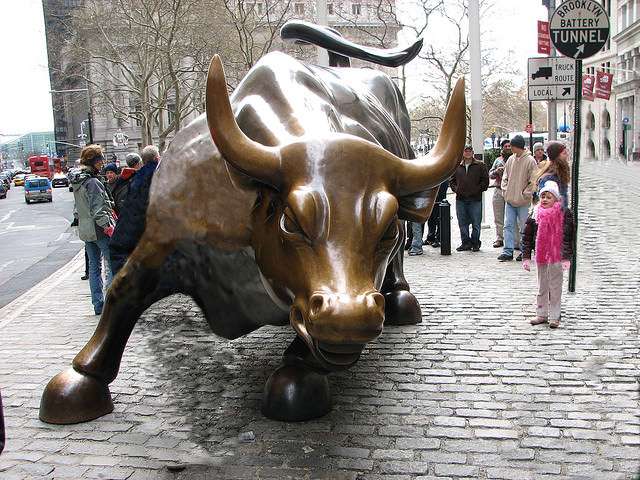How Government Helped Create the Megabanks, and What to Do About Them

If you want to understand the growth of the nation's biggest banks, it helps to understand the history of bank bailouts. Writing in National Affairs, James Pethokoukis of the American Enterprise Institute traces decades of big-bank expansionism, and the government-backed financial sector safety nets that made that expansion possible. It's great piece that serves as a compact history lesson about U.S. banking intervention.
Big banks have long been business, but even still, their growth in recent decades is kind of staggering. In 1983, Pethokoukis notes, "the six biggest American banks had assets equal to 14% of the nation's GDP. Today, their assets equal a staggering 61% of GDP." Not coincidentally, that growth corresponds rather well with a series of demonstrations that the government will prop up banks that fail. That started with the precedent-setting bailout of Unity Bank and Trust, a local Boston bank, in 1971. The Unity bailout ultimately failed when the institution folded in 1982, but more bailouts were on the way in coming years. And with those bailouts, Pethokoukis says, came a domino theory of financial-market interconnectedness which operated on the premise that if one bank fell, others would follow. From there, the idea of banks too big to fail was born.
In a [1984] congressional hearing investigating the bailout, the comptroller of the currency identified 11 bank holding companies, including Continental, as too essential to the financial health of the economy to be allowed to fold. Connecticut congressman Stewart McKinney summed up the testimony by coining a now-famous term: "Let us not bandy words. We have a new kind of bank. It is called too big to fail. TBTF, and it is a wonderful bank."
In effect, large financial institutions had grown beyond the government's ability to regulate. The various measures the government had put in place to protect consumers were no longer adequate for contending with the failure of a big bank. As a result, big banks simply could not be allowed to collapse.
It did not take long for banks to adjust their behavior accordingly. They realized that the bigger and more interconnected they became, the more essential they would seem in the eyes of regulators, and thus the more insulated from failure they would become. This increased security, in turn, afforded the big banks a huge market advantage over their smaller competitors, allowing them to bloat even more — thereby perpetuating a dangerous cycle of uncontrolled growth.
Is there a clear benefit to monster-sized financial institutions? Maybe not. As Pethokoukis argues, they may be more trouble than they're worth.
Megabanks often argue that their size allows them to make use of economies of scale, which is the only way they can compete with massive foreign rivals and provide essential services to American companies working abroad. But there is little evidence that banks need multi-trillion-dollar balance sheets to realize such benefits. In fact, when a bank offers a supermarket of services, it may actually find diminishing returns from the added complexity of its operations. The financial crisis proved that banks can become both too big and too complex to function efficiently.
Former Merrill Lynch CEO John Thain noted this phenomenon in 2009, specifically with reference to the company's business in complex derivatives. "To model correctly one tranche of one [collateralized debt obligation] took about three hours on one of the fastest computers in the United States," Thain explained. "There is no chance that pretty much anybody understood what they were doing with these securities. Creating things that you don't understand is really not a good idea no matter who owns it." More recently, JPMorgan Chase — widely regarded as the best-run bank on Wall Street — suffered a loss of $6 billion when the derivatives gambling of a trader known as the "London whale" went south. The bank's CEO, Jamie Dimon, lamented that this investment strategy was "flawed, complex, poorly reviewed, poorly executed, and poorly monitored."
I'm far from sure that there's anything inherently problematic with very large financial institutions. But there does seem to be a problem with banks that have bulked up in order to help ensure that they large enough that the government will step in, with taxpayer money, to keep them from failing. That's bound to encourage irresponsible growth, and growth for its own sake, rather than the more prudent and careful growth that would be encouraged (though, of course, not guaranteed) under a less bailout-prone regime.
Is such a regime even possible? Pethokoukis argues, plausibly, that policymakers cannot be expected to stand by while megabanks fail. Even if you convince them to say they will, they won't. There's no way to tie their hands, no way to restrain them from intervention in an emergency environment, or what feels like one.
So "the only way to solve the problem of 'too big to fail'", he says, "may be to solve the problem of big banks, period — by taking pre-emptive action to make banks smaller, simpler, and safer." That's tough, and as he admits in his discussion of various policy alternatives designed with that goal in mind, inevitably there will be problems with any policy designed to keep banks down to a manageable size. But given the potentially expensive and/or catastrophic alternatives, it may be worth doing anyway. Certainly it's worth considering.


Show Comments (27)